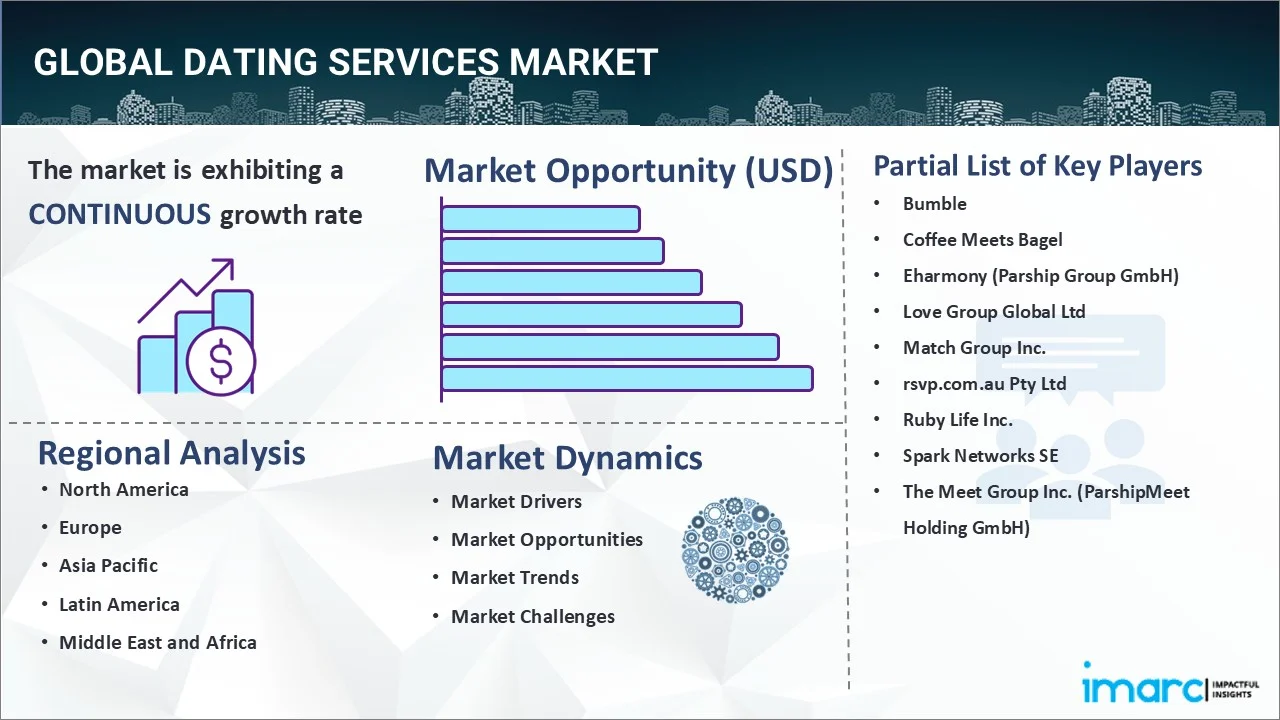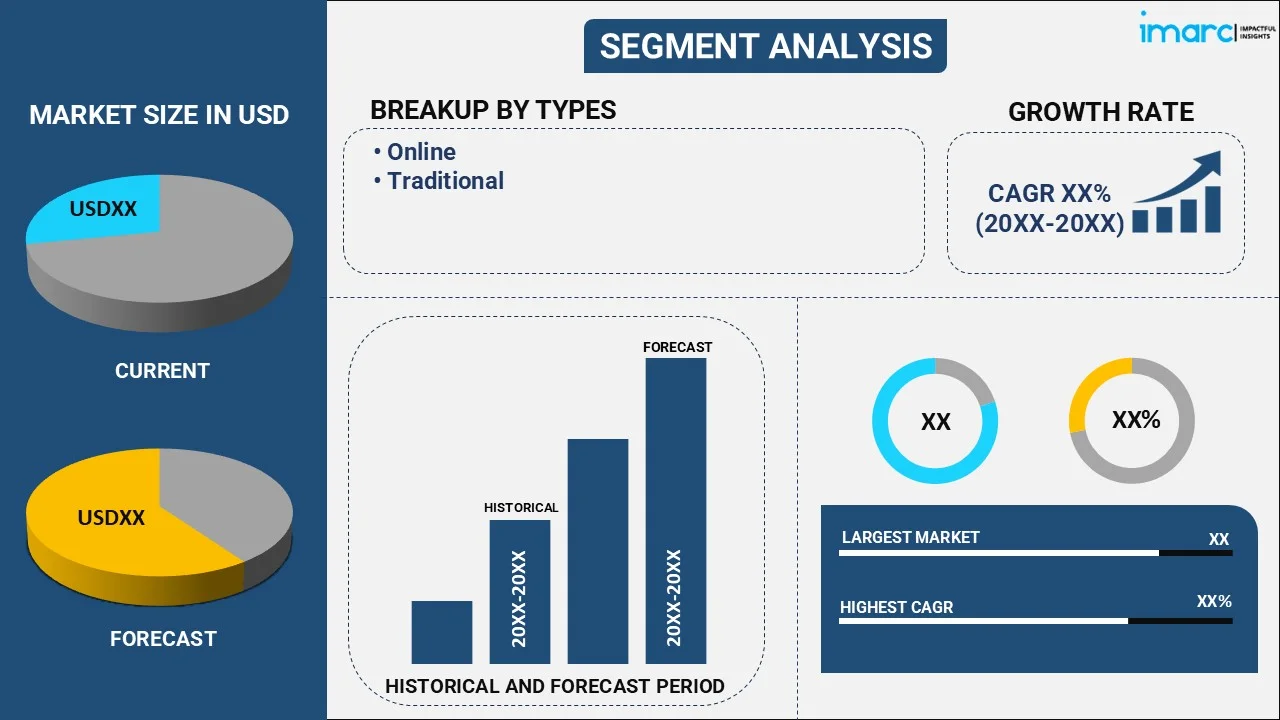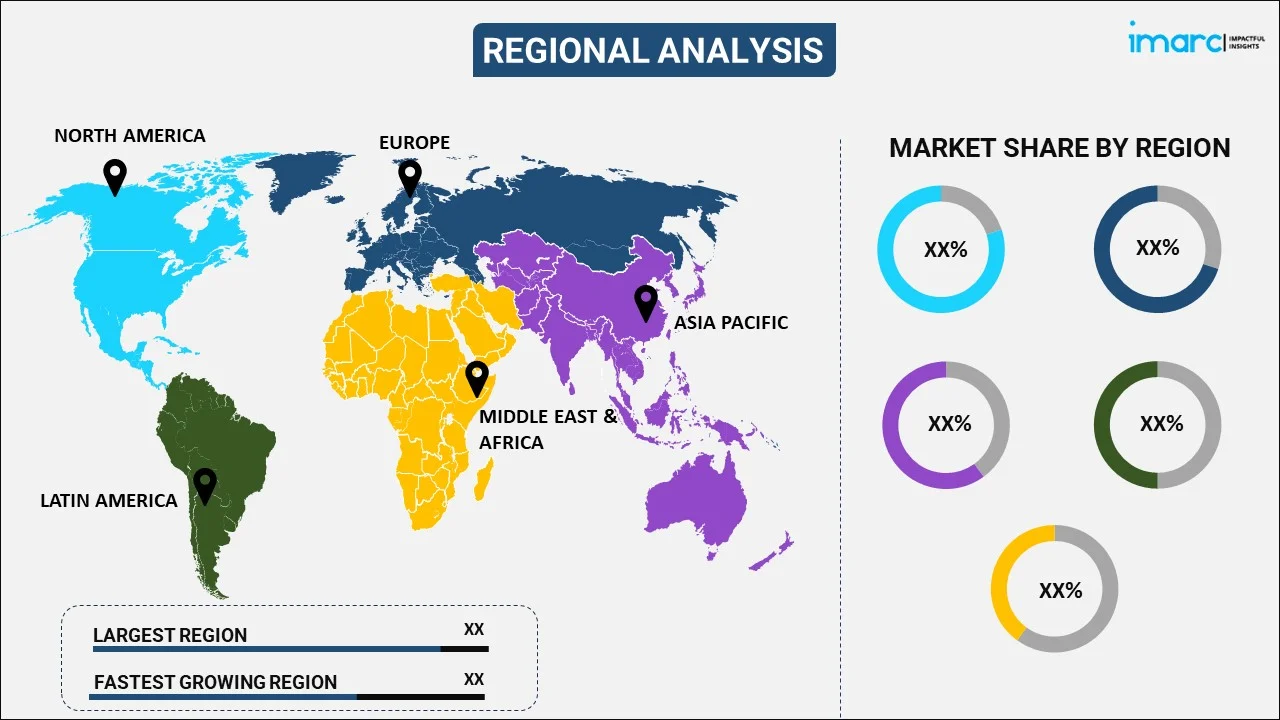
Dating Services Market Report by Type (Online, Traditional), Service (Matchmaking, Social Dating, Adult Dating, Niche Dating), Demographics (Adult, Generation X), and Region 2025-2033
Market Overview:
The global dating services market size reached USD 9.8 Billion in 2024. Looking forward, IMARC Group expects the market to reach USD 16.1 Billion by 2033, exhibiting a growth rate (CAGR) of 5.38% during 2025-2033. The increasing internet connectivity and smartphone usage, evolving societal norms favoring online relationships, rapid urbanization, busy lifestyles necessitating convenient connections, technological advancements in matchmaking algorithms, rising global population and youth demographics, and the impact of the COVID-19 pandemic prompting virtual interactions are some of the factors propelling the market growth.
|
Report Attribute
|
Key Statistics
|
|---|---|
|
Base Year
|
2024
|
|
Forecast Years
|
2025-2033
|
|
Historical Years
|
2019-2024
|
|
Market Size in 2024
|
USD 9.8 Billion |
|
Market Forecast in 2033
|
USD 16.1 Billion |
| Market Growth Rate 2025-2033 | 5.38% |
Dating services encompass online platforms that enable members to forge connections with new individuals, facilitating the pursuit of potential partners. They provide tools such as real-time messaging to bolster communication and facilitate the identification of compatible matches. Online dating services are characterized by user-friendly interfaces, instantaneous messaging options, expansive social networks, and geolocation-based matchmaking capabilities and are notably resonating with the younger demographic. Typically, users autonomously navigate the search process, leveraging search filters that encompass attributes like age, gender, and location, thereby expediting the identification of like-minded matches aligned with their lifestyles and perspectives. Additionally, several dating service operators are incorporating in-app features encompassing voice and video calls, in conjunction with conventional text-based messaging mechanisms, to further enrich interpersonal interactions.

The global dating services market is influenced by the increasing prevalence of internet connectivity and smartphone usage around the world has expanded the potential user base, which is making online dating platforms more accessible. Moreover, shifting societal norms and attitudes towards online relationships and dating have contributed to greater acceptance and adoption of dating services, which is accelerating the market growth. Besides this, the busy modern lifestyle, coupled with rapid urbanization, has led to a higher demand for convenient ways to meet potential partners, further propelling market growth. In line with this, advancements in technology, such as artificial intelligence (AI) algorithms and data analytics, have improved matchmaking accuracy, which is providing a boost to the market growth. Additionally, the rising global population and the integration of social media features within dating platforms are contributing significantly to the market growth.
Dating Services Market Trends/Drivers:
Increasing internet connectivity and smartphone usage
The proliferation of internet connectivity and the widespread adoption of smartphones has significantly impacted the global dating services market. With more people gaining access to the internet and owning smartphones, the potential user base for online dating platforms has expanded. This increased accessibility has transcended geographical boundaries, allowing individuals from various regions to connect and interact on these platforms. As a result, dating service providers have witnessed a surge in user registrations, fostering growth in the industry. The convenience of accessing dating apps and websites via smartphones has further incentivized users to explore online dating, creating a virtuous cycle of increased demand and platform development.
Shifting societal norms and attitudes
Changing societal norms and attitudes towards online relationships and dating have played a pivotal role in driving the global dating services market. As cultural perceptions of online interactions have evolved, the stigma once associated with online dating has diminished, leading to broader acceptance and adoption. This shift in perspective has encouraged a diverse range of individuals, including those who may have been hesitant previously, to embrace online dating as a viable means of meeting potential partners. The prevalent use of social media for personal connections has also contributed to normalizing online interactions, further enhancing the credibility and appeal of dating platforms. This changing landscape has catalyzed the growth of the dating services market, as users increasingly seek convenient and efficient ways to explore romantic relationships.
Rapid urbanization and busy lifestyles
The rapid pace of urbanization and the demands of contemporary lifestyles have fueled the demand for dating services on a global scale. As more people migrate to urban centers for education, career opportunities, and personal growth, the traditional ways of meeting potential partners have become less feasible. The resulting increase in urban loneliness and the challenges of establishing connections in bustling metropolitan areas have prompted individuals to turn to dating services for a solution. The convenience of online dating aligns well with the fast-paced nature of modern life, offering users the flexibility to connect with others despite their busy schedules. This urban-centric demand has prompted dating platforms to innovate and provide tailored solutions that cater to the unique needs of urban dwellers, contributing to the ongoing expansion of the market.
Dating Services Industry Segmentation:
IMARC Group provides an analysis of the key trends in each segment of the global dating services market report, along with forecasts at the global, regional and country levels from 2025-2033. Our report has categorized the market based on type, service and demographics.
Breakup by Type:

- Online
- Traditional
Online dominates the market
The report has provided a detailed breakup and analysis of the market based on the type. This includes online and traditional. According to the report, online represented the largest segment.
The dominance of the online segment in the dating services market can be attributed to the widespread adoption of internet connectivity and smartphones. Moreover, the shift in societal norms has led to increased acceptance of online relationships, encouraging more individuals to explore virtual avenues for connecting with potential partners. In line with this, the convenience offered by online dating aligns with modern lifestyles, enabling users to engage at their own pace and schedule. Moreover, the integration of advanced technologies, like AI-driven matchmaking algorithms, enhances the accuracy of partner recommendations, bolstering user satisfaction. Additionally, the COVID-19 pandemic accelerated the reliance on virtual interactions, further propelling the online segment's growth as people sought safe and meaningful connections while adhering to social distancing measures.
Breakup by Service:
- Matchmaking
- Social Dating
- Adult Dating
- Niche Dating
Social dating dominates the market
The report has provided a detailed breakup and analysis of the market based on the service. This includes matchmaking, social dating, adult dating, and niche dating. According to the report, social dating represented the largest segment.
The dominance of the social dating segment in the global dating services market can be attributed to the prevalence of social media integration within dating platforms, which has expanded the reach and engagement of users, creating a seamless experience for individuals accustomed to interacting online. This integration leverages users' existing social networks, facilitating trust and connection-building. Besides this, the evolution of societal attitudes towards online relationships has led to greater acceptance of social dating platforms as legitimate means of meeting potential partners. Moreover, the convenience of combining dating and socializing within a single platform aligns with the modern lifestyle, catering to users seeking both romantic connections and broader social interactions. In line with this, the COVID-19 pandemic further accelerated the demand for virtual interactions, boosting the adoption of social dating platforms that offer innovative ways to connect digitally.
Breakup by Demographics:
- Adult
- Generation X
Adult dominates the market
The report has provided a detailed breakup and analysis of the market based on the demographics. This includes adult and generation X. According to the report, adult represented the largest segment.
The domination of the adult segment in the dating services market can be attributed to several key factors. Adults often possess greater disposable income and a stronger inclination towards seeking romantic relationships, making them a substantial customer base for dating platforms. Additionally, the increasing acceptance of online dating among adults, fueled by evolving societal attitudes, has contributed to the segment's expansion. Furthermore, the prevalence of busy lifestyles and urbanization has led adults to turn to online dating for convenient and efficient ways to meet potential partners. The integration of advanced matchmaking algorithms and data analytics has improved the accuracy of matches, enhancing user experiences for this demographic. Moreover, the widespread adoption of smartphones and internet connectivity has made online dating accessible to adults across diverse geographies. Besides this, the COVID-19 pandemic accelerated virtual interactions, prompting more adults to explore online dating, further fueling the growth of this dominant market segment.
Breakup by Region:

- North America
- United States
- Canada
- Asia-Pacific
- China
- Japan
- India
- South Korea
- Australia
- Indonesia
- Others
- Europe
- Germany
- France
- United Kingdom
- Italy
- Spain
- Russia
- Others
- Latin America
- Brazil
- Mexico
- Others
- Middle East and Africa
North America exhibits a clear dominance, accounting for the largest dating services market share
The market research report has also provided a comprehensive analysis of all the major regional markets, which include North America (the United States and Canada); Asia Pacific (China, Japan, India, South Korea, Australia, Indonesia, and others); Europe (Germany, France, the United Kingdom, Italy, Spain, Russia, and others); Latin America (Brazil, Mexico, and others); and the Middle East and Africa. According to the report, North America accounted for the largest market share.
North America's dominance in the dating services market can be attributed to several key factors, including the region boasts high internet penetration rates and widespread smartphone adoption, providing a conducive environment for online dating platforms to thrive. Additionally, the region has experienced a shift in societal attitudes towards online relationships, with greater acceptance and normalization. The cultural diversity within the region has led to a varied demand for dating services catering to different preferences and demographics.
Furthermore, urbanization and busy lifestyles have spurred the need for convenient ways to meet potential partners, aligning with the digital nature of dating apps and websites. Technological advancements, particularly in AI algorithms and data analytics, have enhanced matchmaking accuracy, improving user experiences. The prevalence of youth demographics, coupled with a large population, contributes to a substantial user base. Furthermore, the COVID-19 pandemic accelerated the adoption of virtual interactions, pushing dating services to innovate and offer virtual dating experiences, a trend that gained traction in North America.
Competitive Landscape:
The competitive landscape of the global dating services market is characterized by a diverse array of players vying for market share. These entities encompass a mix of established dating platforms, innovative startups, and technology conglomerates entering the space. Intense competition prevails due to low barriers to entry and the evolving nature of consumer preferences.
Key strategies adopted by market participants include continuous technological advancements to enhance user experiences, strategic partnerships to expand user bases, and targeted marketing campaigns to differentiate their offerings. Personalized matchmaking algorithms, stringent safety measures, and integration of social media features are distinguishing factors. As the market witnesses shifts in user behavior and societal norms, players must adapt swiftly to changing trends and preferences. Amidst this dynamic environment, maintaining a competitive edge hinges on a keen understanding of user needs and the ability to deliver secure, convenient, and culturally relevant dating experiences.
The report has provided a comprehensive analysis of the competitive landscape in the market. Detailed profiles of all major companies have also been provided. Some of the key players in the market include:
- Bumble
- Coffee Meets Bagel
- Eharmony (Parship Group GmbH)
- Love Group Global Ltd
- Match Group Inc.
- rsvp.com.au Pty Ltd
- Ruby Life Inc.
- Spark Networks SE
- The Meet Group Inc. (ParshipMeet Holding GmbH)
Recent Developments:
- In July 2023, Spark Networks SE announced several key developments in its ongoing transformational journey, signaling a new chapter in the Company's strategic direction.
- In December 2022, The Meet Group announced the company will join the Tech Coalition, a global alliance working to combat child sexual exploitation and abuse online.
- In July 2023, Bumble announced to release a separate app called “Bumble for Friends” aimed at finding friends in Ireland, New Zealand, Australia, Canada, the Philippines, the U.K., and the U.S. Bumble.
Dating Services Market Report Scope:
| Report Features | Details |
|---|---|
| Base Year of the Analysis | 2024 |
| Historical Period | 2019-2024 |
| Forecast Period | 2025-2033 |
| Units | Billion USD |
| Scope of the Report | Exploration of Historical Trends and Market Outlook, Industry Catalysts and Challenges, Segment-Wise Historical and Predictive Market Assessment:
|
| Types Covered | Online, Traditional |
| Services Covered | Matchmaking, Social Dating, Adult Dating, Niche Dating |
| Demographics Covered | Adult, Generation X |
| Regions Covered | Asia Pacific, Europe, North America, Latin America, Middle East and Africa |
| Countries Covered | United States, Canada, Germany, France, United Kingdom, Italy, Spain, Russia, China, Japan, India, South Korea, Australia, Indonesia, Brazil, Mexico |
| Companies Covered | Bumble, Coffee Meets Bagel, Eharmony (Parship Group GmbH), Love Group Global Ltd, Match Group Inc., rsvp.com.au Pty Ltd, Ruby Life Inc., Spark Networks SE, The Meet Group Inc. (ParshipMeet Holding GmbH), etc. |
| Customization Scope | 10% Free Customization |
| Post-Sale Analyst Support | 10-12 Weeks |
| Delivery Format | PDF and Excel through Email (We can also provide the editable version of the report in PPT/Word format on special request) |
Key Benefits for Stakeholders:
- IMARC’s industry report offers a comprehensive quantitative analysis of various market segments, historical and current market trends, market forecasts, and dynamics of the dating services market from 2019-2033.
- The research report provides the latest information on the market drivers, challenges, and opportunities in the global dating services market.
- The study maps the leading, as well as the fastest-growing, regional markets. It further enables stakeholders to identify the key country-level markets within each region.
- Porter's five forces analysis assist stakeholders in assessing the impact of new entrants, competitive rivalry, supplier power, buyer power, and the threat of substitution. It helps stakeholders to analyze the level of competition within the dating services industry and its attractiveness.
- Competitive landscape allows stakeholders to understand their competitive environment and provides an insight into the current positions of key players in the market.
Key Questions Answered in This Report
The dating services market was valued at USD 9.8 Billion in 2024.
The dating services market is projected to exhibit a CAGR of 5.38% during 2025-2033, reaching a value of USD 16.1 Billion by 2033.
Key drivers of the dating services market include widespread smartphone and internet adoption, changing social norms, busy urban lifestyles, advanced AI-powered matching, growth of niche platforms, increasing single population, enhanced security measures, and integrated video/virtual dating features, boosted by strong digital marketing and social media integration.
North America currently dominates the dating services market due to widespread smartphone/internet penetration, evolving social attitudes, busy urban lifestyles, personalized AI-driven matching, niche platform growth, and the rise of virtual and hybrid (app + offline) dating experiences.
Some of the major players in the dating services market include Bumble, Coffee Meets Bagel, Eharmony (Parship Group GmbH), Love Group Global Ltd, Match Group Inc., rsvp.com.au Pty Ltd, Ruby Life Inc., Spark Networks SE, The Meet Group Inc. (ParshipMeet Holding GmbH), etc.
Need more help?
- Speak to our experienced analysts for insights on the current market scenarios.
- Include additional segments and countries to customize the report as per your requirement.
- Gain an unparalleled competitive advantage in your domain by understanding how to utilize the report and positively impacting your operations and revenue.
- For further assistance, please connect with our analysts.
 Request Customization
Request Customization
 Speak to an Analyst
Speak to an Analyst
 Request Brochure
Request Brochure
 Inquire Before Buying
Inquire Before Buying




.webp)




.webp)












